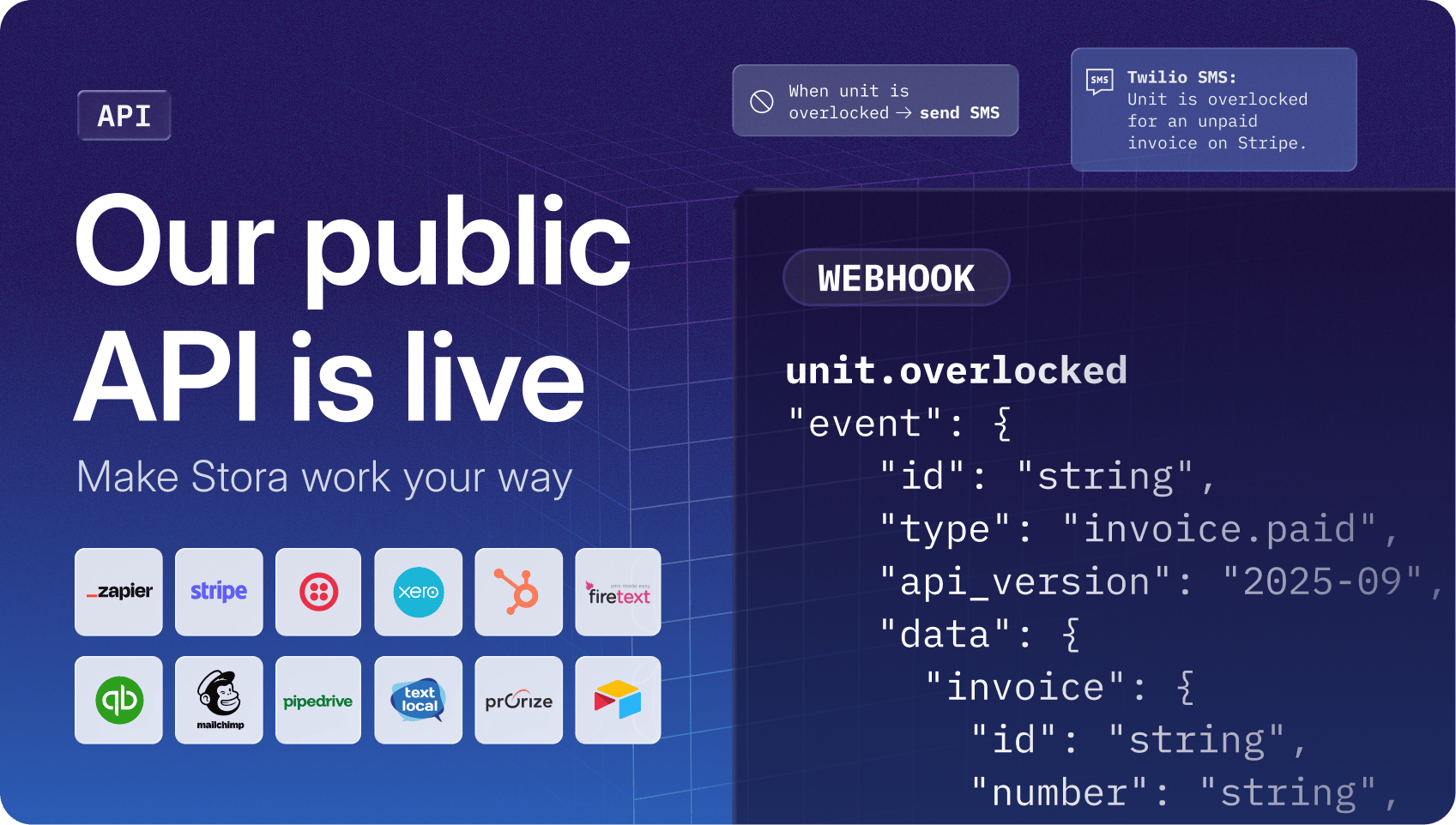If you operate a storage unit, you'll inevitably encounter situations where you must evict a tenant for non-payment or violating your facility's rules.
However, if your tenants weren't properly informed about their responsibilities, you may lack the legal standing required to proceed with eviction procedures.
In this article, we break down the eviction process for storage facilities in the UK and the US. Plus, we’ll share practical tips to help you avoid evictions altogether.
Stay On the Right Side Of the Law
It’s your responsibility to set out the terms of your agreement with your self-storage tenant. Without this, you have no legal basis on which to evict them if the relationship grows sour.
Your terms and conditions should be drafted before you rent out your first unit, and you should have a clear understanding of what the eviction process entails in your region.
🍖 Don’t get stuck with rotten meat Let’s say your tenant decides to store perishables, such as freezers full of meat, but the freezers break unexpectedly, resulting in rotting meat that attracts pests. If your lease agreement doesn’t explicitly state that storing perishables is against the rules, then you don’t have any grounds for an eviction. Instead, you will have to endure the consequences and address the issue without the backing of a clear, legal agreement. This can lead to significant inconvenience, potential health hazards, and damage to your facility's reputation. If you remove the meat without their consent, you may even face legal consequences yourself because they technically weren’t doing anything wrong. |
The best way to make sure you have foolproof contracts in place is to join your local self storage association.
This should include the following:
✅ Access policies: Hours of access and security protocols.
✅ Usage rules: What can and cannot be stored.
✅ Termination conditions: Grounds for eviction and notice requirements.
✅ Liability clauses: Responsibility for damages and insurance requirements.
✅ Payment terms: Due dates, accepted payment methods, and late fees.
With this in place, your tenants will know the terms they need to follow, and you will have clear actions to take if these boundaries are broken.
Source: Pexels
Understanding The Storage Unit Eviction Process
Armed with your legal agreement, you can take action against tenants who don’t abide by your rules and regulations.
However, the storage unit eviction process varies by country and region, with specific legal requirements and timelines for each.
While the rules are generally similar in the US and the UK, there are some key differences:
Item | UK Process | US Process |
Final eviction notice | If your tenant refuses to pay their debt, you issue a final notice giving them a last chance to pay. | You typically issue a lien notice (see glossary), letting tenants know about the lien placed on their unit and details about a potential auction. |
Auction or disposal | Items are sold at auction or disposed of if the tenant's debt remains unpaid after the final notice. | Items can be auctioned off if the tenant hasn't settled their debt by the due date stated in the lien notice. |
Compliance | You must follow UK contract laws and regulations. | You must comply with specific lien laws and auction regulations that vary by state. |
Overlock period (see glossary) | Typically, you wait 30 days after giving notice of default before overlocking the unit or taking further action. | This period varies by state but is often less than 30 days after notifying the tenant of default. |
Auction proceeds | Specific details may vary based on your contract with the tenant. | After settling the debt, any extra money from the auction is returned to the tenant. They have a set period to claim this depending on the state you’re in. |
With this in mind, let's explore the requirements for the storage rental unit eviction process in each of these countries:
1. US storage unit eviction process
Instead of having an overarching storage unit eviction process, the laws and regulations are different in each US state.
In Texas, tenants have 15 days after receiving their first notice to address non-payment or resolve issues, whereas in New York, this period is only around 10 days.
Make sure you read up about the specific laws regarding the storage unit eviction process in your state. This will inform the steps you need to take to effectively evict a difficult tenant.
For example, if you’re based in Texas, you should take the following steps:
Determine the reason for eviction: Make sure the tenant has broken the rental agreement before taking action. If your legal agreement doesn't justify the eviction, you could face legal issues.
Send a termination notice: Inform the tenant about the amount they owe, the deadline for payment (usually 15 days after notice), and what happens if they don't pay rent (their belongings could be auctioned off).
Publish auction notice: If your tenant doesn't pay within 15 days, you must publish a notice of the sale in a local newspaper once a week for two weeks in a row. This notice tells the public about the upcoming auction of the tenant's personal property.
Timing for auction: The auction can take place after the second publication of the notice in the newspaper. In other words, it can be held after 15 days and two weeks from the termination notice.
Tenant's right to redeem: Up to the auction day, the tenant can get their belongings back by paying the overdue rent and fees.
These steps will ensure you stay compliant with Texas state laws and safeguard your business from troublesome tenants.
💰 Getting back what's yours Once you get a tenant out, more than half the battle is won. However, you may still lose money after the auction due to damages to the property or costs associated with legal proceedings and re-renting the unit. You can reclaim these losses in the following ways: ⚖️ Negotiate a settlement: Work with the tenant to agree on a payment plan or lump sum settlement to recover outstanding debts. ⚖️ Small claims court: File a legal claim against the tenant to recover unpaid rent or damages. ⚖️ Garnish their wages: Obtain a court order to deduct money directly from the tenant's wages to cover outstanding debts. ⚖️ Garnish their tax refund: Apply to intercept the tenant's tax refund to offset unpaid rent or damages. ⚖️ Use a debt collector: Hire a professional service to pursue the tenant for outstanding debts through legal means. This may cost you some time, but in the end, you’ll be able to recover your losses. |
2. UK storage unit eviction process
In the UK, you only need to consider a single set of laws and regulations when it comes to self-storage evictions.
If you’re struggling to manage a difficult tenant, you can evict them for non-payment by following these steps:
Within the first 7 days, contact the tenant via phone, email, or SMS to remind them about the overdue payment and late fees.
On day 7, send them an overdue letter using registered mail. This is also a good time to reach out to alternative contacts if you’re struggling to reach them.
Maintain contact through days 7 to 14 to follow up on the overdue payment.
Issue a 14-day overdue letter by day 14, ensuring it is sent at least 14 days after the previous communication. You may also consider offering your tenant an opportunity to remove their goods at a reduced cost.
Send a 28-day immediate access letter via registered mail by day 28, ensuring it is sent at least 14 days after the previous letter.
By day 45, access the storage space under supervision to prepare an inventory and arrange for the valuation of the goods.
Between days 45 and 50, send a final notice by registered mail, including an inventory of the goods and details about the sale or disposal date. Make sure this notice is sent at least 21 days after the previous communication.
By day 75, proceed with selling or disposing of the goods as outlined in the agreement you have with your tenant.
Following these steps ensures you adhere to British Consumer Law, avoiding potential legal repercussions or fines for unlawful storage eviction.
🗄️ The fate of abandoned storage units The UK, which regulates the industry, makes it clear: Auctioning goods from abandoned storage units is illegal. Instead, a proper process must be followed to allow owners to reclaim their property before any sale. Here's how it works:
The SSA UK recommends watching this BBC video to better understand how abandoned storage units are handled in the UK. |
How To Avoid Evictions
Evicting your tenants is a messy business that no storage facility wants to go through.
It costs time, money, and can damage your reputation (see the outrage against storage facilities in New York during the pandemic).
Although evictions are sometimes your only recourse, you should also take steps that may allow you to avoid this, such as:
📞 Joining your local self storage association: These organizations are here to help you navigate the challenges of running a storage facility, including evicting difficult tenants. They provide guidance and answer any questions you may have about managing your business.
💼 Having strong lease agreements: Another benefit of joining your local self-storage association is access to strong lease agreements. This is one of the key advantages that make the membership fees worthwhile.
🕵️♂️ Doing thorough background checks: Verify your tenant’s identification and run a thorough credit check on them to make sure they honour their payment obligations. If anything looks fishy, you can decline their rental application.
💳 Setting up automatic payments: Sometimes people are just tardy. They’re able to pay their rent, but they simply forget to make their payments on time. You can avoid any misunderstandings about this by insisting that your tenants set up automatic payments.
Self storage software, like Stora, allows you to automatically collect rent from tenants at the start of each billing period, making your business run smoother.
🤝 Having someone sign surety: If you have any concerns about a new tenant, you can request that they have a close friend or family member sign surety for them. If you allow this, make sure you thoroughly vet the person signing the surety too.
By following these steps, you may avoid renting to tenants who are likely to default on their contractual agreements.
🌏 Not based in the US or UK? Learn more about the storage unit eviction process for the EU and Australia by respectively visiting these organisations: If you live in another region, simply look up your local self storage association and reach out to them for more details. |
Source: Pexels
In Conclusion
Whether you're in the UK or the US, following the right eviction steps—like giving proper documentation and notices—ensures fairness and protects your business.
While evictions are a last resort, strong lease agreements and thorough tenant screening can often prevent them.
The right software can help you manage your self storage facility by:
🚀 Streamlining rent collection with automated payment systems
🚀 Simplifying tenant management with intuitive software
🚀 Enhancing security with access control features like overlocking
If this sounds like the remedy you’ve been looking for, Stora is the perfect partner for your storage facility.
Get in touch with us today to find out how we can help you automate and manage your storage space.
Glossary
1. Overlock period
An overlock period is the time after a tenant misses payments when the self storage facility owners lock their self storage unit to prevent access until the rent is paid.
2. Lien notice
A lien notice is a legal document that informs a tenant that the storage facility has placed a claim on their stored belongings due to unpaid rent.








